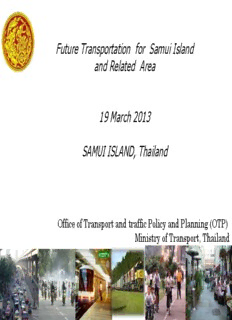
THAILAND'S ENVIRONMENATL SUSTAINABLE TRANSPORT MASTER PLAN AJ-APEIT 27 ... PDF
Preview THAILAND'S ENVIRONMENATL SUSTAINABLE TRANSPORT MASTER PLAN AJ-APEIT 27 ...
Future Transportation for Samui Island and Related Area 19 March 2013 SAMUI ISLAND, Thailand Office of Transport and traffic Policy and Planning (OTP) Ministry of Transport, Thailand TOPIC • Overview of MOT’s Environmental Sustainable Transport Master Plan • Best Practice– Klang Municipality ; community mass transportation system • Way to environmental sustainable transport for “Kho Samui” Ministry of Transport Vision : Toward Sustainable Transport Transport and Economic prosperity Traffic Decrease economic loss (VOT, VOC) Development Increase Competitiveness Master Plan 2011 - 2020 Sustainable Transport Environmental friendly Social & Quality of life Energy saving, Safety, accessibility, Energy efficiency Reduce air emission Equeity, Sufficiency & GHGs reduction Master Plan Development Internal Driving force International Driving Force Environment Environmental Sustainable Economic Transport Masterplan Social SUSTAINABLE TRANSPORT MASTER PLAN Avoid Bangkok Declaration Shift EST Improve CO Emissions per passenger (g/km) 2 Walk & Cycling Z E R O What is sustainable transport? Sustainable transport is a term used to describe transport which has little or no environmental impact. Sustainable travel is any form of transport that keeps damage to our environment, and therefore to the future, to a minimum. “Any from of transport can be sustainable” Public transport, car sharing, walking and cycling … Plus low CO2 emission vehicle –electric & hybrid cars and biodiesel. Low Carbon Transport To be Sustainable Avoid – Saving Carbon Through Urban Development Land Use: Building a city or differently (Singapore, Seoul) Internalizing costs at an early stage of development Shifting the balance away from high-carbon transport Switch: Co-benefits of Transport, Development Bus Rapid Transit and other improvements to transport system, LOS Careful transition from smaller to larger, better managed transit vehicles Congestion pricing and other strategies to reduce externalities Improve by Operations, Technology: Carbon costs Count Lower fuel use/km with improved traffic flow Higher vehicle occupancy Efficient vehicles, low carbon fuels – Mostly national initiatives Finance: Local Authorities, MDBs Demonstrations Measurement and evaluation techniques Source: Lee Schipper, 2009 Avoid – Shift – Improve Concept Shift Improve Divert to Mass Transit Use Renewable Energy such as Bio Fuel Total CO2 Improve Fuel Consumption Reduce traffic/driving distance (avoid) Source: Dr.FuKuda, 2009 Avoid and Shift but also Improve/Mitigate Avoid CO2-Intensive Development: Shift and Strengthen: Singapore Land Use Planning, Mexico City Metrobus Congestion Pricing Improve and Mitigate: Improve and Mitigate: Efficient Vehicles True Low Carbon Fuels
Description: